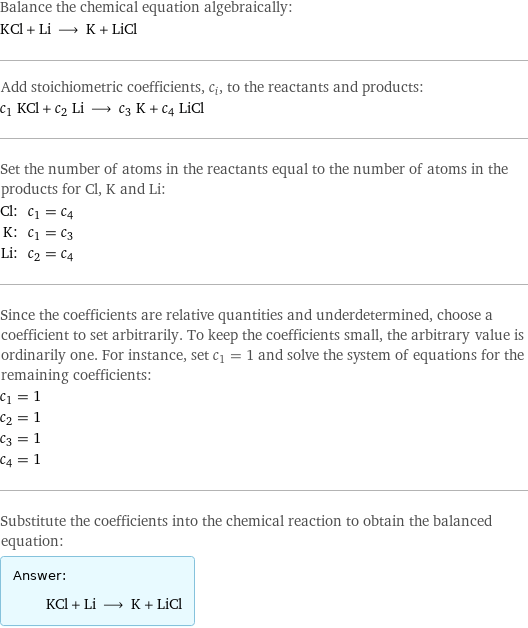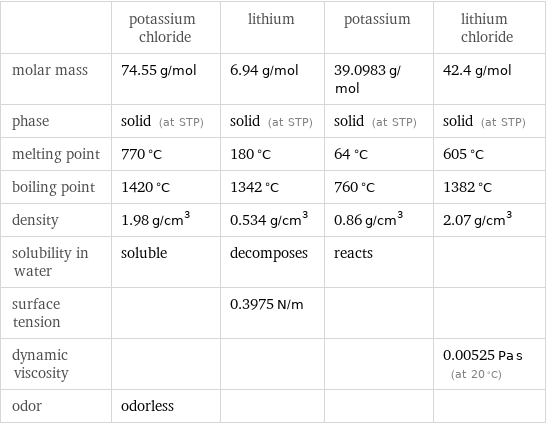Input interpretation

KCl potassium chloride + Li lithium ⟶ K potassium + LiCl lithium chloride
Balanced equation

Balance the chemical equation algebraically: KCl + Li ⟶ K + LiCl Add stoichiometric coefficients, c_i, to the reactants and products: c_1 KCl + c_2 Li ⟶ c_3 K + c_4 LiCl Set the number of atoms in the reactants equal to the number of atoms in the products for Cl, K and Li: Cl: | c_1 = c_4 K: | c_1 = c_3 Li: | c_2 = c_4 Since the coefficients are relative quantities and underdetermined, choose a coefficient to set arbitrarily. To keep the coefficients small, the arbitrary value is ordinarily one. For instance, set c_1 = 1 and solve the system of equations for the remaining coefficients: c_1 = 1 c_2 = 1 c_3 = 1 c_4 = 1 Substitute the coefficients into the chemical reaction to obtain the balanced equation: Answer: | | KCl + Li ⟶ K + LiCl
Structures

+ ⟶ +
Names

potassium chloride + lithium ⟶ potassium + lithium chloride
Equilibrium constant
![Construct the equilibrium constant, K, expression for: KCl + Li ⟶ K + LiCl Plan: • Balance the chemical equation. • Determine the stoichiometric numbers. • Assemble the activity expression for each chemical species. • Use the activity expressions to build the equilibrium constant expression. Write the balanced chemical equation: KCl + Li ⟶ K + LiCl Assign stoichiometric numbers, ν_i, using the stoichiometric coefficients, c_i, from the balanced chemical equation in the following manner: ν_i = -c_i for reactants and ν_i = c_i for products: chemical species | c_i | ν_i KCl | 1 | -1 Li | 1 | -1 K | 1 | 1 LiCl | 1 | 1 Assemble the activity expressions accounting for the state of matter and ν_i: chemical species | c_i | ν_i | activity expression KCl | 1 | -1 | ([KCl])^(-1) Li | 1 | -1 | ([Li])^(-1) K | 1 | 1 | [K] LiCl | 1 | 1 | [LiCl] The equilibrium constant symbol in the concentration basis is: K_c Mulitply the activity expressions to arrive at the K_c expression: Answer: | | K_c = ([KCl])^(-1) ([Li])^(-1) [K] [LiCl] = ([K] [LiCl])/([KCl] [Li])](../image_source/5e0f5e9207df19d4a65471cdf9e781bc.png)
Construct the equilibrium constant, K, expression for: KCl + Li ⟶ K + LiCl Plan: • Balance the chemical equation. • Determine the stoichiometric numbers. • Assemble the activity expression for each chemical species. • Use the activity expressions to build the equilibrium constant expression. Write the balanced chemical equation: KCl + Li ⟶ K + LiCl Assign stoichiometric numbers, ν_i, using the stoichiometric coefficients, c_i, from the balanced chemical equation in the following manner: ν_i = -c_i for reactants and ν_i = c_i for products: chemical species | c_i | ν_i KCl | 1 | -1 Li | 1 | -1 K | 1 | 1 LiCl | 1 | 1 Assemble the activity expressions accounting for the state of matter and ν_i: chemical species | c_i | ν_i | activity expression KCl | 1 | -1 | ([KCl])^(-1) Li | 1 | -1 | ([Li])^(-1) K | 1 | 1 | [K] LiCl | 1 | 1 | [LiCl] The equilibrium constant symbol in the concentration basis is: K_c Mulitply the activity expressions to arrive at the K_c expression: Answer: | | K_c = ([KCl])^(-1) ([Li])^(-1) [K] [LiCl] = ([K] [LiCl])/([KCl] [Li])
Rate of reaction
![Construct the rate of reaction expression for: KCl + Li ⟶ K + LiCl Plan: • Balance the chemical equation. • Determine the stoichiometric numbers. • Assemble the rate term for each chemical species. • Write the rate of reaction expression. Write the balanced chemical equation: KCl + Li ⟶ K + LiCl Assign stoichiometric numbers, ν_i, using the stoichiometric coefficients, c_i, from the balanced chemical equation in the following manner: ν_i = -c_i for reactants and ν_i = c_i for products: chemical species | c_i | ν_i KCl | 1 | -1 Li | 1 | -1 K | 1 | 1 LiCl | 1 | 1 The rate term for each chemical species, B_i, is 1/ν_i(Δ[B_i])/(Δt) where [B_i] is the amount concentration and t is time: chemical species | c_i | ν_i | rate term KCl | 1 | -1 | -(Δ[KCl])/(Δt) Li | 1 | -1 | -(Δ[Li])/(Δt) K | 1 | 1 | (Δ[K])/(Δt) LiCl | 1 | 1 | (Δ[LiCl])/(Δt) (for infinitesimal rate of change, replace Δ with d) Set the rate terms equal to each other to arrive at the rate expression: Answer: | | rate = -(Δ[KCl])/(Δt) = -(Δ[Li])/(Δt) = (Δ[K])/(Δt) = (Δ[LiCl])/(Δt) (assuming constant volume and no accumulation of intermediates or side products)](../image_source/e468bd4c35f523092c0e64a7d351c0ec.png)
Construct the rate of reaction expression for: KCl + Li ⟶ K + LiCl Plan: • Balance the chemical equation. • Determine the stoichiometric numbers. • Assemble the rate term for each chemical species. • Write the rate of reaction expression. Write the balanced chemical equation: KCl + Li ⟶ K + LiCl Assign stoichiometric numbers, ν_i, using the stoichiometric coefficients, c_i, from the balanced chemical equation in the following manner: ν_i = -c_i for reactants and ν_i = c_i for products: chemical species | c_i | ν_i KCl | 1 | -1 Li | 1 | -1 K | 1 | 1 LiCl | 1 | 1 The rate term for each chemical species, B_i, is 1/ν_i(Δ[B_i])/(Δt) where [B_i] is the amount concentration and t is time: chemical species | c_i | ν_i | rate term KCl | 1 | -1 | -(Δ[KCl])/(Δt) Li | 1 | -1 | -(Δ[Li])/(Δt) K | 1 | 1 | (Δ[K])/(Δt) LiCl | 1 | 1 | (Δ[LiCl])/(Δt) (for infinitesimal rate of change, replace Δ with d) Set the rate terms equal to each other to arrive at the rate expression: Answer: | | rate = -(Δ[KCl])/(Δt) = -(Δ[Li])/(Δt) = (Δ[K])/(Δt) = (Δ[LiCl])/(Δt) (assuming constant volume and no accumulation of intermediates or side products)
Chemical names and formulas

| potassium chloride | lithium | potassium | lithium chloride formula | KCl | Li | K | LiCl Hill formula | ClK | Li | K | ClLi name | potassium chloride | lithium | potassium | lithium chloride
Substance properties

| potassium chloride | lithium | potassium | lithium chloride molar mass | 74.55 g/mol | 6.94 g/mol | 39.0983 g/mol | 42.4 g/mol phase | solid (at STP) | solid (at STP) | solid (at STP) | solid (at STP) melting point | 770 °C | 180 °C | 64 °C | 605 °C boiling point | 1420 °C | 1342 °C | 760 °C | 1382 °C density | 1.98 g/cm^3 | 0.534 g/cm^3 | 0.86 g/cm^3 | 2.07 g/cm^3 solubility in water | soluble | decomposes | reacts | surface tension | | 0.3975 N/m | | dynamic viscosity | | | | 0.00525 Pa s (at 20 °C) odor | odorless | | |
Units
